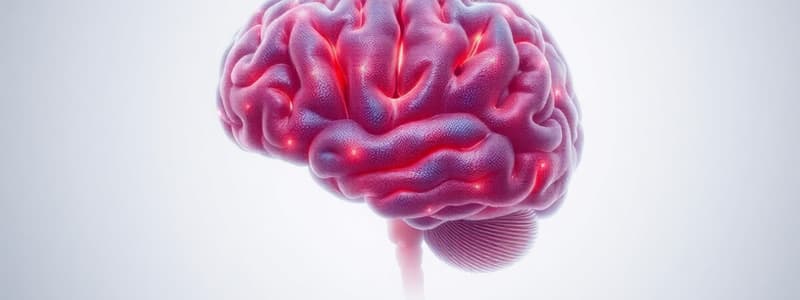Podcast
Questions and Answers
What is the primary function of interoception?
What is the primary function of interoception?
- To monitor external environmental stimuli in real-time
- To regulate emotional expressions through facial feedback
- To perceive and interpret physiological conditions within the body (correct)
- To facilitate communication between the brain and limbs
Which hypothesis suggests that emotions are linked to bodily reactions?
Which hypothesis suggests that emotions are linked to bodily reactions?
- The James-Lange Theory (correct)
- The Facial Feedback Hypothesis
- The Somatic Marker Hypothesis
- The Interoceptive Awareness Theory
What role do somatic markers play according to the Somatic Marker Hypothesis?
What role do somatic markers play according to the Somatic Marker Hypothesis?
- They act as signals to guide behavior based on emotional feelings in the body (correct)
- They quantify emotional experiences without bodily involvement
- They create a direct connection between sensory perception and memory
- They enhance cognitive processing by eliminating emotional input
What is a common objective measure used to assess interoceptive accuracy?
What is a common objective measure used to assess interoceptive accuracy?
How does the baroreflex function in relation to interoception?
How does the baroreflex function in relation to interoception?
What role does the vagus nerve play in gastric interoception?
What role does the vagus nerve play in gastric interoception?
Which statement about individuals with anorexia nervosa (AN) is accurate based on the findings presented?
Which statement about individuals with anorexia nervosa (AN) is accurate based on the findings presented?
What are the two primary ways to perceive heartbeat sensations according to the information provided?
What are the two primary ways to perceive heartbeat sensations according to the information provided?
How does Alexithymia affect individuals with autism according to recent research?
How does Alexithymia affect individuals with autism according to recent research?
What is indicated by the term 'careful with reverse inference' in the context provided?
What is indicated by the term 'careful with reverse inference' in the context provided?
What is primarily responsible for the difference in insula activity between tasks in controls compared to other groups?
What is primarily responsible for the difference in insula activity between tasks in controls compared to other groups?
In relation to empathy, how does activity in the anterior insula correlate with Alexithymia?
In relation to empathy, how does activity in the anterior insula correlate with Alexithymia?
Which group is reported to have a higher prevalence of Alexithymia?
Which group is reported to have a higher prevalence of Alexithymia?
What do the studies suggest about the role of Alexithymia in emotion recognition deficits generally associated with autism?
What do the studies suggest about the role of Alexithymia in emotion recognition deficits generally associated with autism?
What emotion-related aspect does Alexithymia specifically affect according to the content?
What emotion-related aspect does Alexithymia specifically affect according to the content?
Which of the following is not explicitly mentioned as a predictor of insular cortex activity during empathy for pain?
Which of the following is not explicitly mentioned as a predictor of insular cortex activity during empathy for pain?
What methodology was used to test empathy for pain in participants?
What methodology was used to test empathy for pain in participants?
Which of the following statements about emotion and identity categorization tasks is correct?
Which of the following statements about emotion and identity categorization tasks is correct?
How does Alexithymia influence the understanding of one's own emotions?
How does Alexithymia influence the understanding of one's own emotions?
What aspect of Alexithymia is highlighted in its relationship with empathy?
What aspect of Alexithymia is highlighted in its relationship with empathy?
Flashcards
Insula
Insula
A brain region involved in processing bodily sensations, including heartbeat, stomach contractions, and emotional states.
Alexithymia
Alexithymia
A condition characterized by difficulty identifying and describing one's own emotions, often accompanied by reduced awareness of bodily sensations.
Interoception
Interoception
The ability to sense and perceive internal bodily states, such as heart rate or stomach contractions.
Reverse Inference
Reverse Inference
Signup and view all the flashcards
Body Awareness
Body Awareness
Signup and view all the flashcards
What is interoception?
What is interoception?
Signup and view all the flashcards
What is the James-Lange theory of emotion?
What is the James-Lange theory of emotion?
Signup and view all the flashcards
What is the facial feedback hypothesis?
What is the facial feedback hypothesis?
Signup and view all the flashcards
What is the heartbeat counting task?
What is the heartbeat counting task?
Signup and view all the flashcards
What is the insula?
What is the insula?
Signup and view all the flashcards
Empathy
Empathy
Signup and view all the flashcards
Insula Cortex
Insula Cortex
Signup and view all the flashcards
Alexithymia and Insula Cortex
Alexithymia and Insula Cortex
Signup and view all the flashcards
Autism and Alexithymia
Autism and Alexithymia
Signup and view all the flashcards
Self-Awareness and Emotion Recognition
Self-Awareness and Emotion Recognition
Signup and view all the flashcards
Empathy and Alexithymia
Empathy and Alexithymia
Signup and view all the flashcards
Alexithymia and Empathy for Pain
Alexithymia and Empathy for Pain
Signup and view all the flashcards
Alexithymia and Autism: Emotion Recognition
Alexithymia and Autism: Emotion Recognition
Signup and view all the flashcards
Alexithymia as a Potential Cause of Autism Features
Alexithymia as a Potential Cause of Autism Features
Signup and view all the flashcards
Study Notes
Lecture 5 - Insula Cortex and Interoception
- Interoception encompasses pain, temperature, touch, muscular and visceral sensations, vasomotor activity, and hunger
- It's the perception of one's physiological state
- Interoception refers to the representation of the internal states of an organism
- It involves sensing, interpreting, integrating, and regulating signals from within the organism
- This process provides a moment-by-moment mapping of the body's internal landscape
- Interoception is crucial for reflexes, urges, feelings, drives, adaptive responses, cognitive and emotional experiences, homeostasis, body regulation and survival, emotional experience, self-regulation, decision-making and consciousness
- Dysfunction of interoception is linked to anxiety disorders, mood disorders, eating disorders, addictive disorders, and somatic symptom disorders
Measures of Interoception
- Heartbeat counting
- Gastric interoception
- Neural basis of interoception
- The insula
- Interoception and emotions
- Alexithymia and social cognition (especially in autism)
- Emotion recognition and empathy
- Interoception and self-agency
What is Interoception?
- The perception of one's physiological condition
- Includes pain, temperature, touch, muscular, and visceral sensations; vasomotor activity (blood flow regulation); and hunger
- Also includes processes by which the nervous system senses, interprets, and integrates signals originating within the body.
Why is Interoception Important?
- Interoception signaling is a crucial component of reflexes, urges, feelings, drives, adaptive responses, cognitive, and emotional experiences
- It's vital for maintaining homeostasis, body regulation, and survival, in addition to decision-making and consciousness
- Dysfunction can contribute to various mental health conditions (anxiety disorders, mood disorders, eating disorders, addiction disorders, and somatic symptom disorders)
The James-Lange Theory of Emotion
- Emotions are the result of our perception of bodily reactions to a stimulus
- Interoceptive ability is relevant to such "peripheral" theories of emotion
- The free expression of outward signs intensifies emotions, while repression softens emotions
- The facial feedback hypothesis: Facial muscle activation sends feedback signals to the brain influencing our feelings and perception of others.
The Somatic Marker Hypothesis
- Efficient decision-making requires emotion
- Feelings in the body that are associated with emotions, such as the association of rapid heartbeat with anxiety or of nausea with disgust
- Somatic markers act as signals to guide behaviour
Measuring Interoception
- Self-report questionnaires (Multidimensional Assessment of Interoceptive Awareness (MAIA))
- Objective measures (heartbeat counting task, heartbeat tracking, heartbeat discrimination)
The Baroeflex
- A homeostatic mechanism that maintains blood pressure at nearly constant levels
- An elevated blood pressure leads to a decrease in heart rate
Interoception & Emotion in the Insula
- The insula is buried inside the lateral sulcus
- Brain regions like the limbic and cortical regions are also involved in the process of interoception
Insula Connections
- The insula is connected to other areas of the brain, including autonomic centers, premotor, and prefrontal cortex, the cingulate, medial prefrontal cortex, amygdala and OCF
Global Emotional Moments
- Global emotional moments occur when many salient moments take place rapidly, leading to subjective dilation of time.
- Can be measured by the number of heartbeats experienced in a time span.
Interoceptive Accuracy & Awareness
- Confidence in interoceptive accuracy is evaluated via objective tests and self-report measures
Measuring Interoceptive Accuracy
- Heartbeat tracking tasks
- Heartbeat discrimination tasks
Alexithymia
- A subclinical inability to identify emotions in oneself
- Often a co-morbidity in autism, with a higher prevalence compared to the general population.
- Correlates with reduced insular cortex activity during emotional tasks
Empathy
- The study found some evidence that activity in the anterior insula during emotion tasks was positively correlated with empathy, and negatively correlated with alexithymia
- Also, empathy is correlated with alexithymia.
Other Relevant Findings
- Interoceptive accuracy, body ownership, and emotion recognition are key concepts that are related to the anterior insula activity
- Deficits in emotion recognition are related to Alexithymia, not autism.
- Some types of brain cells are crucial for the functions mentioned above. The von Economo neurons
- This could be related to the theory of mind of some animals (e.g. dolphins).
Studying That Suits You
Use AI to generate personalized quizzes and flashcards to suit your learning preferences.




